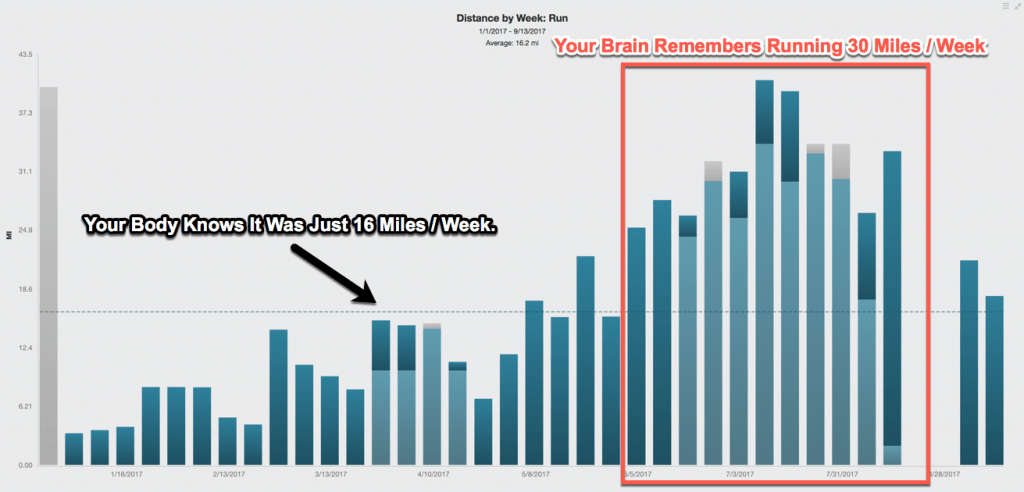One of the biggest issues that endurance athletes face is overreaching. Simply doing too much has the potential for devastating consequences. This is something that everyone knows, but not everyone does. It is a lesson that takes years to learn and is usually a path wrought with injury and setback. But it doesn’t have to be this way.
Your Ego Is the Enemy
No, it’s not some catchy book title (although it’s a fantastic book and you should read it!), It’s a disease. As an endurance athlete, your ego is constantly telling you all the things you could do. You COULD break four hours in a marathon. You COULD ride your bike across the state. You COULD try to race your 15-year-old son in the local 5K. You COULD “jump” into a CrossFit class.
But for every action the ego initiates, the athlete must have an answer.
If the ego is going to provide the initiative, you must provide the direction and the means to get there. It is how you choose to achieve that goal that determines whether or not it becomes a positive for you, or, ultimately a problem.
Avoid Distraction By Using Your Data
Instead of getting in an argument with yourself during your next run, be as objective as possible. Use your own personal data as a guideline from what you’re truly capable of. Instead of guessing what’s possible, take a good hard look at what you’ve actually achieved.
The best means of doing this is checking out your training log. Whether it’s on paper or in digital form, your training log contains the answer to unlocking your true potential.
So before you set some audacious goal for running, pull out your training log and take a good hard look that what your average weekly running volume was for the past 12 months. Most training logs have this baked in, but if not you might have to do a little bit of math either way, knowing this number will give you a good sense of where your run potential lies.
Are You Done Yet?
If so, you’re likely staring at your computer screen in disbelief.
There’s a huge disconnect between what we think we do and what we actually do. Using data to cut to through the noise allows us to make a decision based off of reality.
That number you see there in front of you is essentially your “run fitness score” for the year. That mileage is what you have earned across 365 days. That’s not something you can fake, that’s just reality.
With that number in mind here are some generic guidelines for you regarding mileage:
- Beginner runners generally average between 10 in 15 miles a week across a year.
- Intermediate runners will average between 15 and 20 miles a week across a year.
- Advanced runners will average the between 20 and 30 miles a week across a year.
By using these levels, I’m referring to Age Group Athletes who enjoy being competitive across the season but are not at the elite level.
Please also note that these ability levels are specific to running. You may very well have other sports or things you do that consume your energy and attention at specific times of year.
So for extrapolation purposes, a Beginner-level runner who averages 10 miles of running a week will hit 520 miles in a year. Contrast that with the advanced athlete who averages 30 miles a year to week and will hit 1560 miles. The difference is clear.
The Beginner-level runner needs three years of running to equal the Advanced level runner’s single year of mileage!
Of course, not every mile of running is equal. There are different paces and terrains and conditions. For the purposes of this article we are just considering total mileage completed.
Now That We Know What Your Average Is, It’s Time to Make It Actionable
Break that average number from the last four months down into five separate runs, run / walks, or simply walking (it all depends on your current fitness level). For example, if you averaged 16 miles a week last year, that is essentially four 3-mile runs, and one four-mile run. That is your basic week.
Note: If you have the ability to divide it into more runs, even better. But five runs is an excellent starting point.
The goal here is to have a run distance so short that you can easily fit into any day.
Phase 1: Do That Mileage for Four Weeks
A simple as it sounds, we don’t want anything sexy at the outset. Crazy running when you start is the easiest path to creating problems. Even if your fitness is higher right now, it makes sense to give your body a break and return to the baseline levels which it considers “normal.” Your job is to simply get out and do these five runs across your week at a steady pace. By steady I mean a pace you can run all day. It is a pace at which you could talk to your friends without running out of breath.
Phase 2: Add A Half-Mile to All of Your Runs
As we begin the process of working upwards to a new level of running, we need to do it in baby steps. The easiest way to do this is by simply adding a half-mile to each session. this could be anywhere from 4 to 7 minutes which should be incredibly manageable for you.
The pace doesn’t change. However in this second phase you may enjoy using some different terrain as your run legs will have returned. Again, remember our goal here is to simply get in the consistency…not to strain yourself by overreaching on any single run.
Phase 3: Add the Final Half-Mile to Each Day
This third phase sees you running at the new baseline level we hope to sustain for the remainder of your year. What was once 15 miles per week is now looking like 20 miles! That’s an annual projected increase of 250 miles!
Again, these first four weeks are all about adaptation. The steady pace continues in your adding another 4 to 7 minutes to your total run time. If this puts you into some scheduling difficulty, you can re-allocate the runs across your week accordingly. But the target remains having no run significantly longer then the total mileage divided by five.
In other words, if you are running 20 miles a week 5-4 mile runs should be perfect. Four, 3-mile runs and an 8-mile run would be too much at this point. Remember the frequency of running (number of individual runs) is paramount. Duration and speed will come subsequent to this.
Phase 4: Moving on to the Rest of Your Season
Congratulations! You have now established a new weekly average baseline for your running. Hopefully moving forward into the rest of your season you’re able to maintain this simple baseline level of running.
As you begin to add other sports, shuffle your weeks around to add more training, or to reduce time for recovery — keep this 20 weeks per average in mind.
I encourage you to check back at least once a quarter to see how your mileage is doing and how you are holding up. Once again, using your data is a critical step towards keeping yourself healthy and happy as a runner. If you begin to notice friction or a problem, better to make those changes midstream than waiting too long until they are irreversible.
A New Level of Running Fitness + Bonus Webinar
 As simple as it sounds, this protocol is insanely effective. Hopefully by the end of your year you will be able to look back at a season of successful running.
As simple as it sounds, this protocol is insanely effective. Hopefully by the end of your year you will be able to look back at a season of successful running.
If you want to learn more about the value of run frequency and consistency please consider watching our Run Durability Webinar. Over an hour long, this webinar walks you through all the steps required to build the consistency that will set you free as an athlete.
Instead of just chasing the latest workout craze, or setting an arbitrary goal –take charge of your run fitness and build it in a way that will make you successful for not only the season but for the future as well. Click here to watch that webinar.





Leave a Reply